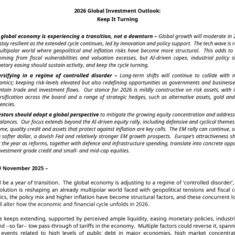Newsroom
2026 Global Investment Outlook: Keep It Turning
London, UK, November 19, 2025

2026 Global Investment Outlook
The global economy is experiencing a transition, not a downturn – Global growth will moderate in 2026, but will stay resilient as the extended cycle continues, led by innovation and policy support. The tech wave is reshaping a multipolar world where geopolitical and inflation risks have become more structural. This adds to concerns stemming from fiscal vulnerabilities and valuation excesses, but AI-driven capex, industrial policy shifts and monetary easing should sustain activity, and keep the cycle turning.
Diversifying in a regime of controlled disorder – Long-term shifts will continue to collide with near-term dynamics; keeping risk-levels elevated but also redefining opportunities as governments and businesses seek to maintain trade and investment flows. Our stance for 2026 is mildly constructive on risk assets, with increased diversification across the board and a range of strategic hedges, such as alternative assets, gold and selected currencies.
Investors should adopt a global perspective to mitigate the growing equity concentration and address US fiscal imbalances. Our focus extends beyond the AI-driven equity rally, including defensive and cyclical themes. In fixed income, quality credit and assets that protect against inflation are key calls. The EM rally can continue, supported by a softer dollar, a dovish Fed and relatively stronger EM growth prospects. Europe’s attractiveness should rise over the year as reforms, together with defence and infrastructure spending, translate into concrete opportunities in investment grade credit and small- and mid-cap equities.
2026 will be a year of transition. The global economy is adjusting to a regime of ‘controlled disorder’, where a tech revolution is reshaping an already multipolar world faced with geopolitical tensions and fiscal concerns. Geopolitics, the policy mix and higher inflation have become structural factors, and these concurrent long-term shifts will alter how the economic and financial cycle unfolds in 2026.
The cycle keeps extending, supported by perceived ample liquidity, easing monetary policies, industrial policy shifts, and – so far -- low pass-through of tariffs in the economy. Multiple factors could reverse it, spanning from adverse events related to high levels of public debt in major economies, high market concentration and valuations, the credibility of central banks and where real rates may stabilise.
Massive AI and Tech-related capex and a decent outlook for earnings could keep valuations higher for longer, but the shifts at play also point to higher structural risks and unpredictable turns in trade and capital flows.
Monica Defend, Head of Amundi Investment Institute, said: “The economy is adapting to a new regime of “controlled disorder”. Tech-led transformation, fiscal stimulus and industrial policy are keeping activity alive and leading to the emergence of new winners. Inflation becomes a structural theme investors must also factor into their allocations”.
Vincent Mortier, Group CIO of Amundi, added: “Diversification remains the most effective defence in a world of concentrated equity markets and high valuations. Investor portfolios must rebalance across styles, sectors, sizes and regions to mitigate risks and capture opportunities, notably in Emerging Markets and European assets.”
CENTRAL SCENARIO: A TRANSITION, NOT A DOWNTURN
In 2026, dovish central banks and global investment in tech, defence, and infrastructure, should continue to inject momentum into a phase of the cycle that would otherwise begin to slow.
Global growth is moderating but proves broadly resilient, thanks to innovation led by capex and policies aimed at strategic autonomy. Inflation risks persist due to pro-cyclical policies, ceaseless reconfiguration of supply-chains and challenges from the energy transition.Broadly appropriate monetary policy is increasingly pressured by fiscal dominance. We forecast global GDP growth at 3.0% in 2026 and 3.1% in 2027 (from 3.3% in 2025), with DM at 1.4% and 1.6% on average, and EM at 4.0% and 4.1%.
US growth should experience a shallow slowdown in the coming quarters, before picking up to reach 1.9% in 2026 and 2.0% in 2027, remaining below potential. The current pace of AI and Tech-related investment seems unsustainable and should moderate before broad productivity gains materialise. Consumption should remain a key driver of the economy but moderate, due to above-target inflation, weaker income and labour market dynamics, where evidence shows that low-income households are facing constraints on affordability. We expect the Fed to cut twice in the first half of 2026, to 3.25% and the USD to weaken, but the journey will not be linear.
In Europe, we expect growth to remain below potential at 0.9% in 2026, then to recover at 1.3% in 2027, both in the Eurozone and in the UK. The European journey depends on domestic demand, monetary-policy support and on the effective implementation of prospective reforms. The aim of the latter is to transform the macro-financial system and to drive private investment towards strategic autonomy over the medium term. The German plan is a game changer, but the region’s aggregate fiscal stance should stay neutral as high debt levels and fiscal rules push many countries towards consolidation. Higher defence spending could further support the recovery. We anticipate the ECB will ease beyond current market expectations, to 1.5% by mid-2026, and the BoE will bring down rates to 3.25%.
Emerging Markets assets offer broad opportunities. EM has benefited from easier global financial conditions, balanced domestic policies and front-loaded export demand in 2025. Growth will likely stabilise but keep outpacing that of developed economies. Cautious monetary easing should continue, with no signs of fiscal dominance. Asia will remain the primary growth engine, despite moderating growth in China (4.4% and 4.2%) and India (6.3% and 6.5%). In LatAm, a series of elections could usher in more business-friendly administrations. Structural forces are also at play: geopolitical realignment, supply‑chain reconfiguration and an intensifying technological race, in which Asia stands out.
Risks to our central scenario stem from multiple fronts. They are significant on the downside, but we also see some upside. Adverse (geo)political or financial shocks - including fiscal dominance or financial repression - could trigger a market downturn, for example by de-anchoring expectation as to what level inflation or interest rates will stabilise, by disappointing on business performance or investments, or by tightening liquidity. Conversely, reduced geopolitical or tariff tensions, higher fiscal- or deregulation-led investments or broader signs of AI-related productivity gains would improve the outlook.
INVESTMENT IMPLICATIONS: DIVERSIFYING IN AN ERA OF CONTROLLED DISORDER
Under the assumption of no economic recession in 2026, our call is moderately pro-risk. Our allocation seeks to play growth through the tech-led recovery globally while diversifying into low‑correlated themes and a range of strategic hedges.
In Fixed Income, we see a continuation of the diversification trend and are mindful of risks stemming from imbalances in the US. The current backdrop calls for a tactical approach to duration and a neutral-to-slightly-short stance on sovereigns. Quality credit becomes a core allocation for fixed income investors to diversify away from Treasuries, and it is clearly overweight. We remain cautious on US High Yield and Japanese government bonds. A positive stance on European bonds remains a key call for 2026, with a focus on peripheral bonds and short maturities, UK Gilts and investment grade credit, particularly in financials. While sticky inflation calls for seeking opportunities in inflation break-evens.
In Equities, sector and style allocation will drive performance in 2026. We favour exposure beyond the AI-race into the broadening tech theme - including power energy, computing, materials needed to overcome physical constrains that are building - and a combination of defensive and cyclical themes. We are overall neutral on US equities despite the Fed’s procyclical stance and will add on our equal-weighted approach given market concentration and high valuations. European industrials and infrastructure should provide new entry points in H2 2026 to benefit from a structurally weaker USD and longer-term themes (defence spending, electrification and repatriation of assets from the US) and revived interest in the Eurozone if the German plan materialises and reforms advance. We are positive on European Financial, Industrial, Defence and Green-transition sectors, as well as on small and mid-caps. Europe can still play the tech cycle through Industrials and Capital Goods. We also seek opportunities into the expanding Asian tech ecosystem. Japan can also benefit from the corporate reform and weaker Yen.
We are overall positive on Emerging Assets. EM bonds stand out for high income and diversification, while EM equities offer a diversified set of opportunities. We like attractive yields in Hard Currency debt. In Local Currency debt, we favour Central and Eastern Europe, selective parts of LatAm (Columbia, Brazil) and Asia (India, Philippines and Korea) for carry and valuation. We are positive on EM equities and see notable pockets of opportunities favouring value and momentum styles in LatAm and Eastern Europe and selectively in Asia, in sectors linked to digital assets. In Chinese equity, we expect to move from neutral to select positions in the tech sector and areas of clear comparative advantage (EV supply chain, renewable energy). We are positive on India with a medium term horizon where the ‘Make in India’ transformation offers long term growth potential in many fields (manufacturing, consumption, infrastructure, global supply-chain shifts, financial inclusion technologies). Key risks across EMs are a stronger US dollar and higher US Treasury yields.
Diversification & Hedges. For real-return resilience, we favour greater allocation to alternative income and inflation hedges in real assets. Private credit and infrastructure are well positioned to benefit from structural themes such as electrification, reshoring, AI, and robust demand for private capital, particularly in Europe. Diversification should also structurally include a broader commodities exposure, in particular to gold, and selected currencies such as JPY, EUR, and emerging currencies that may benefit from a weaker dollar. We favour high-carry currency such as the Brazilian Real or South African Rand and Asia.
Experts
Vincent has been Group Chief Investment Officer since February 2022. Previous to that, he was the Group Deputy CIO of Amundi since 2015. He is a member of the Globa[...]
Read moreMonica Defend, Head of Amundi Investment Institute. Monica is Head of the Amundi Investment Institute, which was created in February 2022, and a member of Amundi's Exe[...]
Read moreContact

Danae Quek
UK - International Press Relations
About Amundi
About Amundi
Amundi, the leading European asset manager, ranking among the top 10 global players[1], offers its 100 million clients - retail, institutional and corporate - a complete range of savings and investment solutions in active and passive management, in traditional or real assets. This offering is enhanced with IT tools and services to cover the entire savings value chain. A subsidiary of the Crédit Agricole group and listed on the stock exchange, Amundi currently manages more than €2.3 trillion of assets[2].
With its six international investment hubs[3], financial and extra-financial research capabilities and long-standing commitment to responsible investment, Amundi is a key player in the asset management landscape.
Amundi clients benefit from the expertise and advice of 5,600 employees in 35 countries.
Amundi, a trusted partner, working every day in the interest of its clients and society
Footnotes
- ^ [1] Source: IPE "Top 500 Asset Managers" published in June 2024 based on assets under management as of 31/12/2023
- ^ [2] Amundi data as at 31/03/2025
- ^ [3] Paris, London, Dublin, Milan, Tokyo and San Antonio (via our strategic partnership with Victory Capital)
Footnotes





